Raised bogs are ombrogenous, i.e. are fed by rainwater, as they develop on deep peat which forms a barrier between the bog surface and groundwater sources. The habitat is relatively scarce in Wales and there are no ‘pristine’ examples, they have all been modified to a greater or lesser extent by peat cutting and drainage, with some examples also impacted by pipe-laying and burns. Two of the raised bogs in Wales are well known, however: Cors Caron for being the best example of a raised mire complex in the UK and Cors Fochno for being the largest single raised bog plateau in the UK. The reference state for raised bog vegetation and examples of modified states are given below.
Raised bog
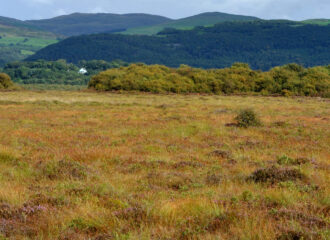
Reference state 1 – Hummock and hollow habitat
The reference state for a raised bog should comprise what is referred to as a ‘hummock and hollow’ complex, where hummocks of ‘building’ bog mosses, such as Sphagnum papilllosum and Sphagnum subnitens, and ericoids form a mosaic with pool or ‘wet hollow species, such as Sphagnum cuspidatum, Sphagnum pulchrum and Rhynchospora alba. This hummock/hollow patterning…
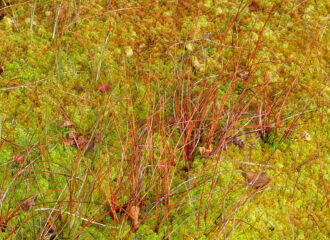
Reference state 1a – Sphagnum-dominated hollows
The extent, distribution and patterning of bog pools, typically dominated by the feathery bog moss (Sphagnum cuspidatum), on a raised bog surface can be good indicators of condition. The main threat to raised bog vegetation is drying as a consequence of historic (and sometimes ongoing) peat-cutting and drainage activities, one of the first and most…
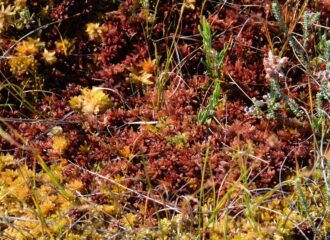
Reference state 1b – Sphagnum-dominated hollows
Although the wetter hollows on the plateaux of Welsh raised bogs tend to be dominated by the feathery bog moss Sphagnum cuspidatum, at some sites (notably Cors Fochno) carpets of the golden bog moss (Sphagnum pulchrum) and Magellanic bog moss (Sphagnum magellanicum) can also be found. These species occur only locally on raised bogs in…
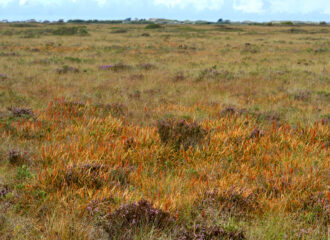
Reference state 2 – Hummocks with bog asphodel-dominated hollows
Although many of the wet hollows on a raised bog surface are dominated by bog mosses, other hollows can be dominated by bog asphodel (Narthecium ossifragum). The leaves of the bog asphodel plants turn bright orange as the autumn progresses making the distribution of these hollows relatively easy to see.
Read more Reference state 2 – Hummocks with bog asphodel-dominated hollows
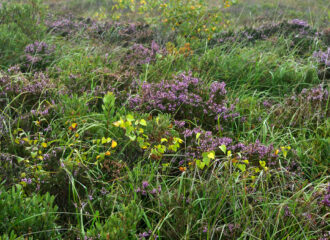
Reference state 3 – Hummock-dominated bog with bog myrtle scrub
Stands of bog myrtle (Myrica gale) can form in some of the more mature and drier hummock-dominated areas around the edges of a raised bog. Although wet hollows will be scarce or absent in vegetation dominated by heath and shrub species, the areas with bog myrtle at Cors Caron and Cors Fochno are important for…
Read more Reference state 3 – Hummock-dominated bog with bog myrtle scrub

Modified state 1 – Cut-over bog
One sign of peat cutting or drainage is the spread of purple moor grass (Molinia caerulea) on the bog surface, as seen here at Cors Caron, where it covers vast areas of secondary bog surface. On a healthy raised bog, purple moor grass would only achieve dominance in the sloping edges of the bog, aka…
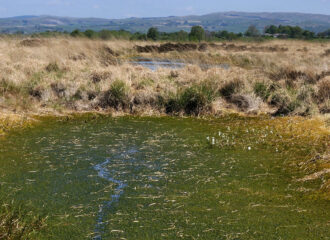
Modified state 2 – Excavated pools on secondary bog surface
Another modified state of secondary raised bog, especially in wetter parts, can be extensive lawns of bog moss, particularly of Spagnum cuspidatum. In healthy raised bog habitat, Sphagnum cuspidatum would be just one component of the bog pool flora that forms a hummock and hollow complex on the raised bog plateau.
Read more Modified state 2 – Excavated pools on secondary bog surface
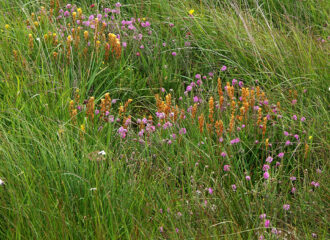
Modified state 3 – Cut-over and drained secondary bog surface
Raised bogs that have been impacted by intensive peat-cutting and drainage activities not only lose the distinctive ‘domed’ appearance, they also lose the typical hummock and hollow patterning of a raised bog surface. Furthermore, the vegetation can become quite difficult to classify, as the species composition can closely resemble wet heath or marshy grassland communities.
Read more Modified state 3 – Cut-over and drained secondary bog surface

